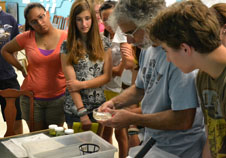Youths shore up their science knowledge

From the coastal shores of Northeastern’s Marine Science Center (MSC) in Nahant, Mass., high school students this summer found themselves contributing to a massive global mission to assess ocean life.
The experiential learning opportunity for the young biologists was part of the center’s Coastal Ocean Science Academy, a two-week summer program run each summer that introduces high school students to marine science. The Marine Science Center is a first-class teaching laboratory where faculty members and Northeastern students can pursue use-inspired, interdisciplinary research on topics ranging from the sonar monitoring of fish populations, to the security applications of robotic lobsters and lampreys.
The surveys were conducted through the “Summer Science in New England” program, which is funded by the National Oceanographic and Atmospheric Administration and coordinated by the New England Aquarium. The academy joined nine other high school summer programs in conducting the marine life surveys.
The results of the students’ nearshore survey—which was conducted under the direction of assistant professor of biology Matt Bracken—will be included in the Census of Marine Life, an international initiative to assess and understand ocean life. The students’ work will be cataloged along with more than 30 million records already compiled over the last 10 years by scientists from around the world.
“It’s significant that high school students are contributing to an international effort,” said Carole McCauley, outreach program coordinator at the Marine Science Center.
During the two-week program, students also seine fished along the shore and compared plankton levels in deep water and surface environments on an oceanography cruise in Boston Harbor.
The academy concluded with students presenting research projects, including an analysis of fecal coliform levels in Boston Harbor and a look at the diversity of marine life at different elevations along the shore’s gradient.
McCauley noted, “We’re exposing students to different topics, with an eye on having them ask questions and find out how scientists answer them. They are challenged to think about the interrelations of marine life.”




